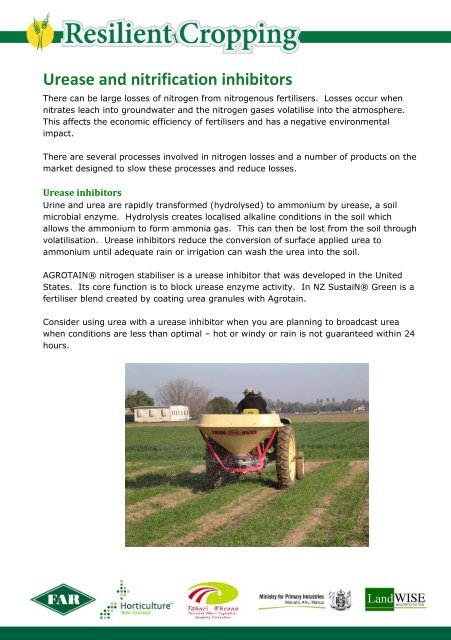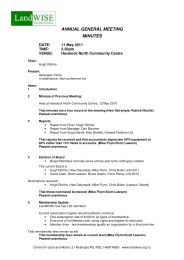Urease and nitrification inhibitors - FAR
Urease and nitrification inhibitors - FAR
Urease and nitrification inhibitors - FAR
Create successful ePaper yourself
Turn your PDF publications into a flip-book with our unique Google optimized e-Paper software.
<strong>Urease</strong> <strong>and</strong> <strong>nitrification</strong> <strong>inhibitors</strong><br />
There can be large losses of nitrogen from nitrogenous fertilisers. Losses occur when<br />
nitrates leach into groundwater <strong>and</strong> the nitrogen gases volatilise into the atmosphere.<br />
This affects the economic efficiency of fertilisers <strong>and</strong> has a negative environmental<br />
impact.<br />
There are several processes involved in nitrogen losses <strong>and</strong> a number of products on the<br />
market designed to slow these processes <strong>and</strong> reduce losses.<br />
<strong>Urease</strong> <strong>inhibitors</strong><br />
Urine <strong>and</strong> urea are rapidly transformed (hydrolysed) to ammonium by urease, a soil<br />
microbial enzyme. Hydrolysis creates localised alkaline conditions in the soil which<br />
allows the ammonium to form ammonia gas. This can then be lost from the soil through<br />
volatilisation. <strong>Urease</strong> <strong>inhibitors</strong> reduce the conversion of surface applied urea to<br />
ammonium until adequate rain or irrigation can wash the urea into the soil.<br />
AGROTAIN® nitrogen stabiliser is a urease inhibitor that was developed in the United<br />
States. Its core function is to block urease enzyme activity. In NZ SustaiN® Green is a<br />
fertiliser blend created by coating urea granules with Agrotain.<br />
Consider using urea with a urease inhibitor when you are planning to broadcast urea<br />
when conditions are less than optimal – hot or windy or rain is not guaranteed within 24<br />
hours.
<strong>Urease</strong> <strong>and</strong> <strong>nitrification</strong> <strong>inhibitors</strong><br />
Nitrification <strong>inhibitors</strong><br />
Nitrification is a bacterial process that converts ammonium to nitrite <strong>and</strong> nitrate. It is a<br />
core part of the nitrogen cycle. The bacteria responsible for these processes are<br />
specialist Nitrosomonas <strong>and</strong> Nitrobacter species.<br />
Nitrification takes two to three weeks in warm, aerated soils. In anaerobic conditions<br />
the process is reversed by other micro-organisms <strong>and</strong> de<strong>nitrification</strong> converts nitrate to<br />
nitrous oxide <strong>and</strong> nitrogen gas.<br />
Nitrification <strong>inhibitors</strong> slow the process by inhibiting the activity of the Nitrosomonas<br />
bacteria <strong>and</strong> ammonium concentrations increase. Most soils have a net negative charge<br />
<strong>and</strong> the positively charged ammonium ion sticks onto the soil exchange surfaces. They<br />
are slowly dissolved in the soil water <strong>and</strong> can be used by plants or immobilised into soil<br />
organic matter.<br />
Eco-N <strong>and</strong> DCn are two <strong>nitrification</strong> <strong>inhibitors</strong> on the New Zeal<strong>and</strong> market. Their active<br />
ingredient is di-cy<strong>and</strong>iamide (DCD). These products are seen as being important in<br />
reducing the impact of nitrogen losses on the environment <strong>and</strong> there has been<br />
considerable investment in researching their on farm use. However the results have<br />
been variable because of the complexity of the soil <strong>and</strong> farm systems<br />
<strong>FAR</strong> research on urease <strong>and</strong> <strong>nitrification</strong> <strong>inhibitors</strong><br />
In <strong>FAR</strong> funded research on wheat. Seven trials over three years evaluated the plant<br />
response to urea, DCn <strong>and</strong> SustaiN.<br />
Soil mineral N was measured in the trial site to calculate the nitrogen application rates.<br />
The fertilisers <strong>and</strong> <strong>nitrification</strong> <strong>inhibitors</strong> were broadcast during stem extension. Yield<br />
response was compared with a control.<br />
No advantage to SustaiN was found in five of the seven trials. At most of these sites,<br />
rain fell within a few days of treatments being applied, so there was no benefit to using<br />
SustaiN over urea or DCn to reduce volatilisation.<br />
Results from maize research trials show that SustaiN may be a useful option where<br />
growers are broadcasting fertiliser in dry conditions<br />
Reference; Arable Updates 69 Nitrification <strong>and</strong> urease <strong>inhibitors</strong>, <strong>and</strong> Arable update 193<br />
Comparing urea SustaiN <strong>and</strong> DCn for broadcasting over wheat<br />
Arable Updates 69, Comparing urea <strong>and</strong> SustaiN for broadcasting over maize<br />
<strong>FAR</strong> HortNZ L<strong>and</strong>WISE Inc Tahuri Whenua<br />
03 345 5783 04 472 03795 06 650 4531 06 356 7589<br />
www.far.org.nz www.hortnz.co.nz www.l<strong>and</strong>wise.org.nz www.tahuriwhenua.org.nz



